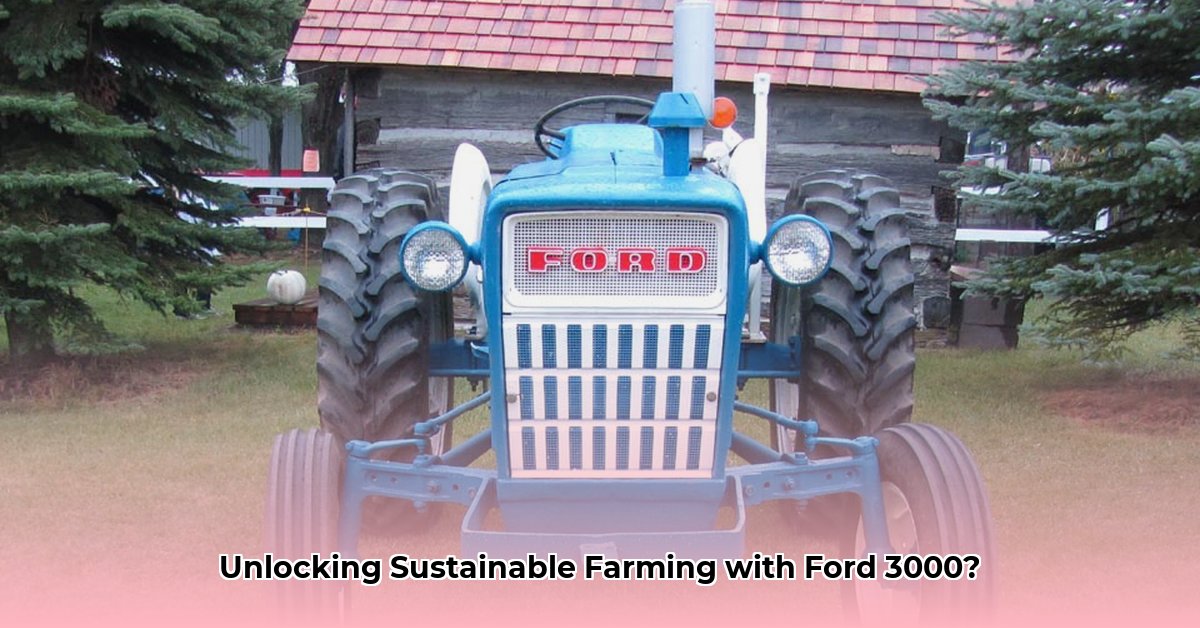
A Workhorse with a History
The Ford 3000, a ubiquitous sight on farms from the mid-1960s to the mid-1970s, wasn't just any tractor; it symbolized a pivotal advancement in agricultural mechanization. Its robust construction and dependable performance quickly established it as a farmer favorite. But how does its horsepower—a key factor in efficiency and environmental impact—measure up against contemporary standards of sustainable agriculture? For more on tractor horsepower, see this helpful resource: Tractor Horsepower. This article delves into the Ford 3000's historical context, its power output, and its environmental consequences, comparing it to modern tractors and examining the challenges associated with maintaining vintage machinery. Whether you're a vintage tractor enthusiast or a farmer prioritizing sustainable practices, this exploration offers a comprehensive understanding of the Ford 3000's legacy in modern farming.
The Power Behind the Ford 3000: A Closer Look
The Ford 3000's horsepower wasn't a fixed number, varying depending on whether a gasoline or diesel engine powered the machine. Both options were available, each exhibiting distinct power output and fuel consumption characteristics. While precise fuel efficiency data from that era is limited, it's widely acknowledged that fuel efficiency wasn't a primary design consideration. The priority was robust power for demanding farm tasks.
Here's a summary of typical engine specifications, acknowledging variations based on model year and configuration:
| Engine Type | Horsepower (approx.) | Torque (approx.) | Transmission |
|---|---|---|---|
| Gasoline | 35-45 | Variable | 3-speed or 4-speed manual |
| Diesel | 36-48 | Variable | 3-speed or 4-speed manual |
This table reveals a machine built for brute strength. But how environmentally responsible was this strength, given today's standards?
The Ford 3000 and the Environment: A Retrospective
How does the Ford 3000 align with contemporary sustainability goals? Frankly, it falls short in several critical areas. Compared to modern tractors, emission controls were virtually nonexistent, resulting in significantly higher greenhouse gas emissions. Fuel consumption was likely higher than modern equivalents, further exacerbating its environmental impact. Moreover, the tractor's substantial weight, while contributing to its power, likely resulted in considerable soil compaction. Soil compaction negatively affects soil health, reducing water absorption and root growth, thereby diminishing crop yields and overall environmental sustainability. Isn't it interesting to consider how these factors affect long-term soil health and agricultural practices?
Then and Now: A Generational Comparison
Modern tractors present a stark contrast, boasting significantly improved fuel efficiency and dramatically reduced emissions. Advancements like turbocharging and sophisticated emission control systems have made a substantial difference. Additionally, precision farming technologies—such as GPS-guided machinery—enhance fuel efficiency, minimize chemical use, and reduce environmental impact. While the Ford 3000's power was impressive for its era, it's simply outmatched by the sustainable farming solutions available today.
Challenges of Maintaining a Classic
Owning a vintage Ford 3000 presents unique challenges. Sourcing replacement parts can be time-consuming and expensive. Safety features are significantly less advanced than those on modern tractors, posing potential risks. The environmental implications of operating older machinery, including increased emissions and potential for increased fuel consumption, also require careful consideration. It's a tradeoff: appreciating agricultural history versus embracing environmentally conscious practices.
A Legacy of Progress: The Broader Perspective
The Ford 3000 played a vital role in agricultural mechanization. However, its contribution to sustainable practices is undeniably limited by its age and technology. Its history serves as a compelling reminder of the remarkable progress made in agricultural technology and the ongoing need for innovation in agricultural equipment. This legacy underscores the importance of continuous efforts to develop more efficient and environmentally friendly farming methods to feed a growing population while protecting the planet. The path towards truly sustainable agriculture remains a journey of continuous improvement and innovation.
How to Assess the Environmental Impact of a Ford 3000 Tractor
Key Takeaways:
- The Ford 3000's historical context is crucial for understanding its environmental impact.
- A comprehensive assessment requires considering factors beyond horsepower, including fuel consumption and emission levels.
- The challenges of maintenance and parts availability also influence its overall environmental footprint.
A Look Back: The Ford 3000's Era
The Ford 3000, manufactured between 1965 and 1975, wasn't designed with modern sustainability standards in mind. This historical context is vital for a fair assessment of its environmental impact. Evaluating it against current standards requires understanding the technological limitations of its era.
Unpacking the Specifications
A comprehensive assessment requires examining key specifications:
- Engine Type: Gasoline or diesel; diesel generally offers superior fuel economy but different emission profiles.
- Fuel Consumption: Data on fuel burn rate per hour is crucial for calculating environmental impact. This data may be available in owners' manuals or online forums.
- PTO Power: Power takeoff (PTO) horsepower indicates the work capacity per unit of fuel.
The Environmental Equation: Fuel, Emissions, & Soil
Assessing the environmental impact extends beyond fuel efficiency:
- Emissions: Older engines lacked modern emission controls, significantly increasing greenhouse gas emissions.
- Soil Compaction: The tractor's weight contributes to soil compaction, harming soil structure and decreasing water infiltration.
- Maintenance: Sourcing parts from environmentally responsible suppliers and using sustainable lubricants are crucial considerations.
Comparing the Past to the Present
Comparing the Ford 3000 to modern tractors underscores technological advancements:
| Feature | Ford 3000 (Approximate) | Modern Tractor (Example) |
|---|---|---|
| Fuel Efficiency | Low | High |
| Emissions | High | Low |
| Technology | Basic | Advanced |
Challenges & Considerations
Maintaining a vintage Ford 3000 presents challenges: sourcing parts is often difficult and expensive. Safety features are limited compared to modern tractors. These factors also influence its environmental impact.
In conclusion, evaluating the environmental impact of a Ford 3000 requires a nuanced perspective, acknowledging its historical context and technological limitations. While precise quantification of its ecological impact is challenging, understanding its design, usage, and maintenance provides valuable insights into its role in agricultural history and its contribution to the ongoing discussion concerning sustainable practices.